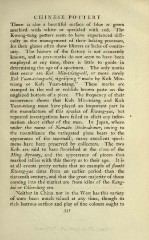Page 429 - Oriental Series Japan and China, Brinkly
P. 429
CHINESE POTTERY
There is also a beautiful surface of blue or green
marbled with white or speckled with red. The
Kwang-tung potters seem to have experienced diffi-
culty in the management of their baking processes,
for their glazes often show blisters or lacks of contin-
uity. The history of the factory is not accurately
known, and as year-marks do not seem to have been
employed at any time, there is little to guide in
determining the age of a specimen. The only marks
that occur are Koh Min-tsiang-chi, or more rarely
Koh Tuan-tsiang-chiy signifying " made by Koh Min-
tsiang or Koh Yuan-tsiang." These marks are
stamped in the red or reddish brown paste on the
unglazed bottom of a piece. The frequency of their
occurrence shows that Koh Min-tsiang and Koh
Yuan-tsiang must have played an important part in
the manufacture of this species of Kwang-yao, but
repeated investigations have failed to elicit any infor-
mation about either of the men. In Japan, where
under the name of Namako (beche-de-mer, owing to
the resemblance the variegated glaze bears to the
appearance of the sea-snail), many excellent speci-
mens have been preserved by collectors. The two
Koh are said to have flourished at the close of the
Ming dynasty, and the appearance of pieces thus
marked tallies with this theory as to their age. It is
at all events pretty certain that no example of flambe
Kwang-yao dates from an earlier period than the
sixteenth century, and that the great majority of those
coming into the market are from kilns of the Kang-
hsi or Chlen-lung era.
Neither in China nor in the West has this variety
of ware been much valued at any time, though its
rich lustrous surface and play of fine colours ought to
35 1

